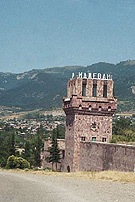
|
The
name “Ijevan”
means “Inn,” reflecting the Tavush capital’s
previous name of Karvansara (though also Istibulagh), stopping
place on an important E-W road and also, since 1870, of the
railroad.
In the place called Hamam-Jala on the bank of the Aghstev
are remains of a medieval caravansaray.
On the N side
of the main
road at the W end
of town |
|
Crossing
the Aghstev river by the bridge on
the W end of town, a right turn leads to Gandzakar
(till 1978 Aghdan) with S. Gevorg church, a S. Kiraki chapel of
1286, Budur cyclopean fort E atop Budur mountain, with two 12-13th
c. churches with khachkars in the forest nearby. To the W
of upper Gandzakar is the ruined
medieval
Tanik fort. There is
supposed |
UNDER
CONSTRUCTION
|
|
(cannon outside) is a small
historical/ethnographic museum reopened in 1999, with a diorama
commemorating the entry of the Red Army in 1920.
Ijevan has a large (dormant?) rug factory, and wood
product factories. There is a 200-bed high-rise hotel built in 1969 on the N
side of the main road. In
the SW part of town is a S. Hovhannes
church.
Chamber tombs near the city hospital and a
Late Bronze
Age cemetery on the left bank of river attest early occupation
of the site.
|
|
to be a ruined “Ashot Yerkat” fort
6 km SW.
However, another source says the Ashot Yerkat fort is 7
km W of Ijevan.
From Gandzakar the road winds up a narrow set of unpaved
switchbacks toward Berd and the Shamsadin region. |